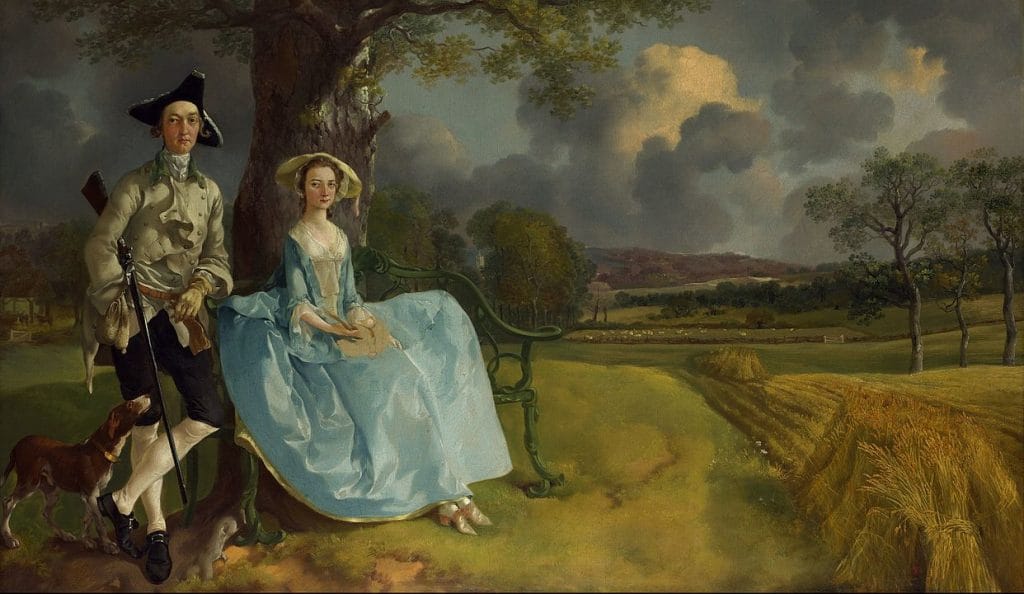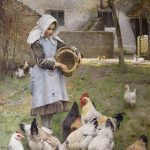
Thomas Gainsborough’s Mr and Mrs Andrews is one of the most captivating portraits of 18th-century British art. Painted around 1750, this oil on canvas masterpiece blends portraiture with landscape in a way that was groundbreaking for its time. The painting is more than just a depiction of a wealthy couple—it is a statement on land ownership, social status, and artistic innovation. Today, it remains one of Gainsborough’s most celebrated works, admired for its meticulous detail and subtle storytelling.
Currently housed at the National Gallery in London, the painting has intrigued art historians and critics for centuries. Its composition, the expressions of the sitters, and even the unfinished section on Mrs. Andrews’ lap have sparked countless debates. Gainsborough’s ability to merge the grandeur of the human subjects with the beauty of the English countryside showcases his mastery of both genres. Unlike many portraits of its time, Mr and Mrs Andrews does not simply present the sitters in an artificial, posed manner; instead, it captures a dynamic relationship between people and place.
The artwork is a testament to the wealth and status of its subjects, yet it also raises questions about power and privilege. The landscape is not just a backdrop—it is an essential part of the painting’s message. Gainsborough subtly highlights the couple’s control over their land, reflecting broader themes of aristocracy and property rights in 18th-century England. This makes the painting a fascinating historical document as well as an artistic triumph.
By exploring the artist, the subjects, and the deeper meanings behind Mr and Mrs Andrews, we can gain a richer understanding of why this painting remains relevant today. Whether one is drawn to its artistic brilliance, historical significance, or the mysteries it holds, Gainsborough’s masterpiece continues to captivate audiences across generations.
Thomas Gainsborough: The Artist Behind the Canvas
Thomas Gainsborough (1727–1788) was one of the most important British painters of the 18th century, known for his exceptional skill in both portraiture and landscape painting. Born in Sudbury, Suffolk, he showed artistic talent from an early age and later trained in London. Unlike many of his contemporaries, Gainsborough never fully embraced the grandeur of historical painting, preferring the natural beauty of landscapes and the subtle charm of portraiture. His ability to blend these two genres set him apart from other artists of his time.
Gainsborough’s early works focused primarily on landscapes, a genre that remained close to his heart throughout his career. However, financial necessity led him to specialize in portraiture, which was far more lucrative. Despite this, he often infused his portraits with detailed natural scenery, as seen in Mr and Mrs Andrews. His love for landscapes was evident in his later years when he turned almost exclusively to painting idyllic countryside scenes, often using a loose, expressive brushwork that foreshadowed the Romantic movement.
His rivalry with Sir Joshua Reynolds, the first president of the Royal Academy, shaped much of his career. While Reynolds advocated for a more structured, classical approach to portraiture, Gainsborough favored a more spontaneous, fluid style. This difference in artistic philosophy led to tensions, but it also cemented Gainsborough’s reputation as an innovator. His refusal to conform to rigid artistic conventions allowed him to develop a distinctive voice in British art.
Among his most famous works are The Blue Boy, The Market Cart, and The Morning Walk, all of which showcase his talent for capturing human expression and atmospheric beauty. Yet, Mr and Mrs Andrews remains unique in its composition, blending the formal elegance of portraiture with the expansive charm of an English countryside scene. It is this harmonious fusion that makes the painting one of his most enduring and studied masterpieces.
The Subjects: Who Were Mr and Mrs Andrews?
The painting’s subjects, Robert Andrews and Frances Carter, were members of the English landed gentry, a social class that derived its wealth and influence from agriculture. Robert Andrews, the son of a prosperous landowner in Suffolk, inherited significant estates, while Frances Carter came from a similarly privileged background. Their marriage was not just a union of love but also a consolidation of wealth and power, a common practice among the elite of the time.
Robert Andrews is depicted standing with a rifle tucked under his arm, exuding confidence and authority. His pose, casual yet commanding, reflects his role as the master of the land behind him. Frances, seated beside him on an ornate wooden bench, is dressed in an elegant blue silk gown. Her expression, cool and reserved, has intrigued art historians for years. While Robert’s gaze meets the viewer’s directly, Frances appears more detached, almost indifferent to the grand display of wealth around her.
The Andrews’ estate, stretching far into the horizon, dominates the background. This vast expanse of cultivated land serves as a symbol of their wealth and social standing. The carefully tended wheat fields emphasize the economic power derived from agriculture, reinforcing the couple’s privileged position. Unlike many portraits of the time, which featured neutral or decorative backgrounds, this painting uses the landscape as an active element in the narrative.
Commissioning a portrait like this was a way for aristocratic families to reinforce their status. While it celebrates their prosperity, it also subtly exposes their self-perception. The carefully chosen elements—the hunting rifle, the lavish clothing, the expansive property—are all deliberate, crafted to project an image of affluence and control. Yet, there remains an air of mystery about the relationship between the couple, leaving modern viewers to speculate about the dynamics within their marriage.
Composition and Style: A Unique Artistic Approach
One of the most striking aspects of Mr and Mrs Andrews is its composition, which breaks away from the rigid formality of traditional portraiture. Instead of placing the sitters in a grand, indoor setting, Gainsborough integrates them into the open countryside. This decision not only highlights his skill as a landscape painter but also reinforces the connection between the subjects and their land.
The positioning of the figures is particularly interesting. Robert Andrews stands to the left, his body angled slightly toward his wife, yet he maintains a sense of independence. Frances, seated on an elaborate wooden bench, occupies the right side of the canvas. The space between them, combined with her detached expression, creates a subtle tension that art historians have long debated. Was Gainsborough making a statement about their marriage, or was this merely a stylistic choice?
Gainsborough’s mastery of texture is evident in every aspect of the painting. The delicate folds of Frances’ silk gown contrast beautifully with the rough texture of the wooden bench and the crisp, golden wheat fields. The artist’s brushwork brings the entire scene to life, from the wispy clouds in the sky to the intricate details of the couple’s clothing. Each element is carefully rendered to create a sense of depth and realism.
The painting’s color palette is also worth noting. The cool blues of Frances’ dress contrast with the warm tones of the surrounding landscape, drawing the viewer’s eye toward her figure. The subtle variations in the greens and browns of the fields add to the naturalistic feel of the painting. These artistic choices reflect Gainsborough’s ability to capture both the beauty of the human form and the splendor of the natural world.
Symbolism and Hidden Meanings
At first glance, Mr and Mrs Andrews appears to be a straightforward portrait of a wealthy couple enjoying their land. However, a closer examination reveals layers of symbolism that hint at deeper themes. The landscape, for instance, is not just a picturesque setting—it is a declaration of ownership and control. The neatly divided fields, the distant tree line, and the well-maintained hedgerows all emphasize the structured, cultivated nature of the estate.
One of the most discussed aspects of the painting is the empty space on Frances Andrews’ lap. Some art historians believe this area was left unfinished, possibly intended for a later addition, such as a book, a pet, or even a child. Others argue that the empty space itself is symbolic, representing unfulfilled expectations, particularly regarding heirs and lineage. This small but significant detail adds an element of mystery to the work.
The couple’s expressions also contribute to the painting’s enigmatic nature. While Robert appears self-assured and somewhat smug, Frances’ expression is more ambiguous. Her gaze is distant, and her body language is reserved, leading some scholars to interpret this as dissatisfaction or reluctance. Could Gainsborough have been subtly commenting on the rigid expectations placed upon women in aristocratic marriages?
Additionally, the hunting rifle carried by Robert Andrews signifies masculinity, dominance, and control—both over nature and his social position. In contrast, Frances’ delicate pose and fine attire reinforce traditional gender roles of the era. Through these carefully chosen elements, Gainsborough weaves a complex narrative about wealth, power, and the roles of men and women in 18th-century England.
Landscape as More Than a Backdrop
The landscape in Mr and Mrs Andrews is far more than just a setting—it is an active and essential element of the painting’s narrative. Gainsborough’s depiction of the rolling Suffolk countryside reflects his deep love for nature, but it also serves to highlight the wealth and social standing of the subjects. The land, meticulously cultivated and divided into neat sections, is a direct symbol of ownership and control. By presenting the couple in front of this vast estate, Gainsborough reinforces their status as members of the landed gentry.
Unlike many portraits of the time, where backgrounds were often generic or purely decorative, Gainsborough’s approach integrates the landscape as a key part of the composition. The golden wheat fields, stretching far into the distance, emphasize the prosperity that agriculture brought to families like the Andrews. The presence of large, mature trees suggests stability and heritage, qualities that would have been highly valued by the aristocracy. This deliberate inclusion of detailed farmland suggests that the couple’s identity is inseparable from the land they own.
Gainsborough’s skill as a landscape painter is evident in the soft, naturalistic rendering of the sky and foliage. The delicate, wispy clouds suggest movement, adding a sense of life to the scene. The rolling hills in the background create depth, leading the viewer’s eye into the distance. Unlike the more rigid, formal landscapes often seen in portraits of the period, this setting feels organic and carefully observed, reflecting Gainsborough’s deep appreciation for nature.
The contrast between the carefully structured farmland and the more untamed areas of greenery adds another layer of meaning. The wheat fields symbolize human cultivation and control, while the wilder patches of trees and grass hint at nature’s untamed beauty. Gainsborough’s ability to balance these elements demonstrates his artistic mastery, making the landscape an integral part of the painting’s overall message rather than just a passive backdrop.
The Painting’s Condition and Unfinished Aspects
One of the most intriguing aspects of Mr and Mrs Andrews is its apparent unfinished section—Frances Andrews’ lap. Unlike the rest of the painting, which is rich in detail and texture, this area is strikingly blank. Art historians have long speculated about Gainsborough’s intentions. Some believe he planned to add an object such as a book, a pet, or a child but never completed it, either due to external circumstances or because the Andrews family never requested further work.
The idea that this space was meant for a child is particularly compelling. In the 18th century, producing heirs was of great importance to aristocratic families. The absence of a child in the portrait might suggest that the couple had not yet started a family at the time of its creation, leaving room for a future addition. Alternatively, the emptiness could symbolize something deeper—a commentary on Frances’ role in the marriage and her potential lack of autonomy in an era where women’s identities were often tied to motherhood.
Over the years, the painting has been carefully preserved, with little evidence of major deterioration. Gainsborough’s use of high-quality oil paints and fine canvas has contributed to its longevity. However, close examination has revealed subtle cracks and minor wear, typical of works from this period. The National Gallery has undertaken conservation efforts to ensure that the painting remains in excellent condition for future generations.
Interestingly, some scholars have proposed that the unfinished section was a deliberate artistic choice rather than an oversight. Gainsborough may have intended for the space to remain ambiguous, allowing viewers to draw their own conclusions. This intentional mystery adds to the painting’s allure, making it one of the most discussed works in British art history. Whether unfinished by accident or design, this element contributes to the portrait’s unique and enigmatic character.
Reception and Legacy: How the Painting Was Viewed Over Time
At the time of its creation, Mr and Mrs Andrews was likely a private commission, meant to be displayed in the Andrews’ home rather than exhibited publicly. Gainsborough was still an emerging artist in the 1750s, and his style was not yet fully embraced by the artistic establishment. As a result, the painting did not gain widespread recognition during his lifetime. However, over the centuries, it has come to be regarded as one of the most significant works of 18th-century British art.
The painting’s rediscovery and reevaluation in the 20th century brought new attention to its innovative composition and deeper social commentary. Art historians began to see it not just as a portrait of a wealthy couple but as a complex statement on class, land ownership, and marital dynamics. The enigmatic expressions of the sitters, particularly Frances Andrews’ reserved demeanor, have led to various interpretations, ranging from feminist readings to economic critiques.
The integration of landscape and portraiture in Mr and Mrs Andrews has influenced many later artists. While Gainsborough was not the first to combine these elements, his seamless blending of the two genres set a precedent for future painters. His approach can be seen in the works of later British artists such as John Constable, who admired Gainsborough’s naturalistic landscapes and sought to capture the English countryside with a similar sensitivity.
Today, Mr and Mrs Andrews is one of the most recognized paintings in the National Gallery’s collection. It is frequently referenced in art criticism, museum exhibitions, and academic discussions. Its ability to evoke curiosity and debate ensures that it remains a cornerstone of British art history, continuously inspiring new interpretations and appreciation.
List of Notable Critics and Historians Who Analyzed the Work
- John Berger – Examined themes of power and land ownership in Ways of Seeing.
- Sir Roy Strong – Explored Gainsborough’s innovative approach to portraiture.
- Kenneth Clark – Focused on the painting’s artistic techniques and unfinished elements.
- T.J. Clark – Analyzed the class implications and historical context.
- Linda Nochlin – Offered a feminist perspective on Frances Andrews’ depiction.
Mr and Mrs Andrews in Popular Culture
The widespread appeal of Mr and Mrs Andrews has extended far beyond the art world, making appearances in literature, film, and even modern advertising. The painting’s distinct composition and air of aristocratic elegance have made it a favorite for reinterpretation and parody. In contemporary art, several artists have reimagined the painting, sometimes adding humorous or critical elements that challenge traditional views of wealth and privilege.
One of the most famous reinterpretations comes from British artist Yinka Shonibare, who recreated the couple with African textiles, questioning colonialism and class dynamics. Additionally, the painting has appeared in museum exhibitions that explore themes of land ownership and historical power structures. These reinterpretations demonstrate how Gainsborough’s work remains relevant, sparking new discussions about art and society.
In literature, Mr and Mrs Andrews has been referenced in novels and essays discussing themes of marriage, property, and social expectation. Its inclusion in John Berger’s Ways of Seeing brought renewed attention to its underlying messages, particularly concerning the connection between wealth and representation in art. The painting’s ability to provoke debate makes it a frequent subject of academic analysis.
Even popular media has drawn inspiration from Mr and Mrs Andrews. From satirical cartoons to period dramas, its imagery continues to be reimagined. Whether used as a symbol of historical privilege or as a backdrop for modern storytelling, Gainsborough’s masterpiece remains an enduring cultural touchstone.
Conclusion: A Timeless Masterpiece
More than just a portrait, Mr and Mrs Andrews is a statement about wealth, power, and artistic innovation. Gainsborough’s ability to seamlessly blend landscape with portraiture makes the painting a unique and influential work in British art history. Its enigmatic elements, from the couple’s expressions to the unfinished lap of Mrs. Andrews, ensure that it continues to inspire curiosity and scholarly debate.
The painting’s legacy has grown over the centuries, transforming from a private commission into a celebrated masterpiece. Its place in the National Gallery allows millions of viewers to appreciate Gainsborough’s skill and vision firsthand. As one of the most studied and discussed works in 18th-century art, it remains a critical piece for understanding both the social structures and artistic movements of the time.
For those interested in British art, Mr and Mrs Andrews is a must-see. Its intricate details, subtle storytelling, and historical significance make it an enduring favorite among art lovers and scholars alike. By examining its themes and artistic techniques, we gain deeper insight into both Gainsborough’s genius and the world in which he painted.
Whether viewed as a symbol of aristocratic pride or as a commentary on social hierarchies, Mr and Mrs Andrews continues to captivate audiences. Its blend of elegance, mystery, and artistic brilliance ensures its place as one of the most remarkable portraits ever created.




